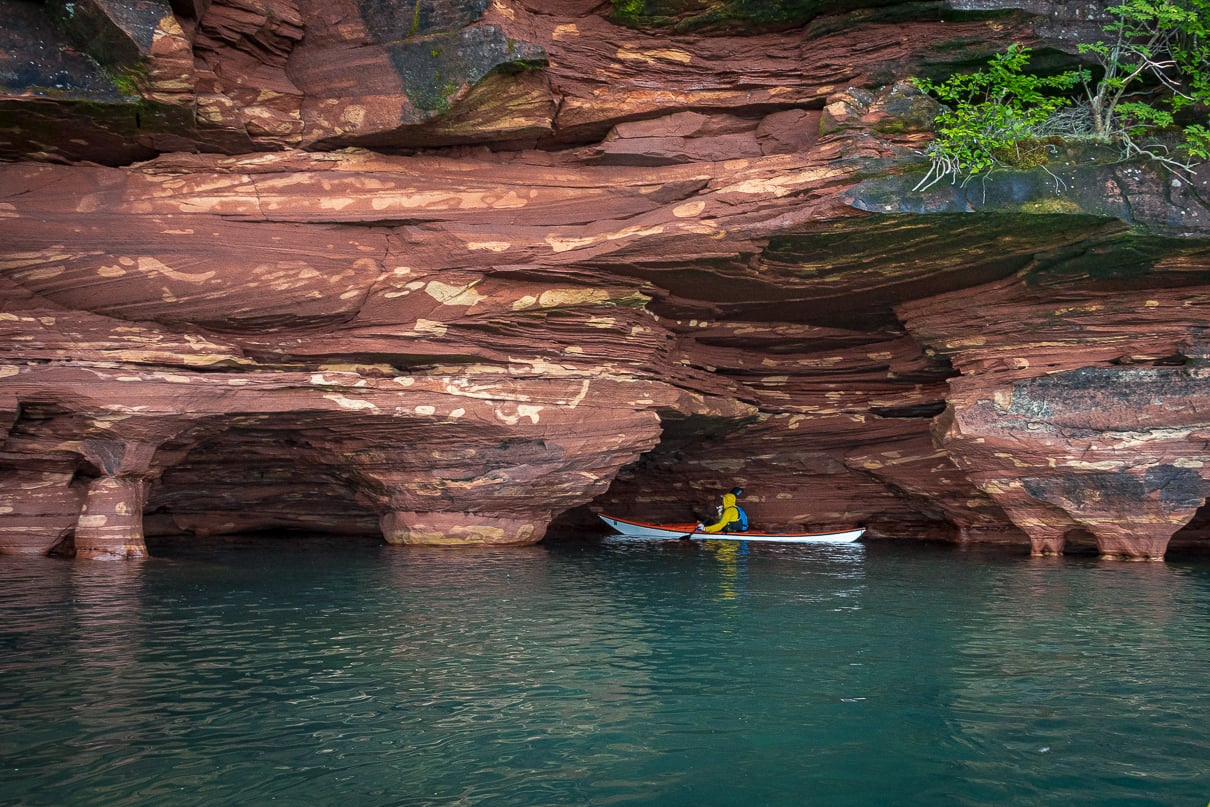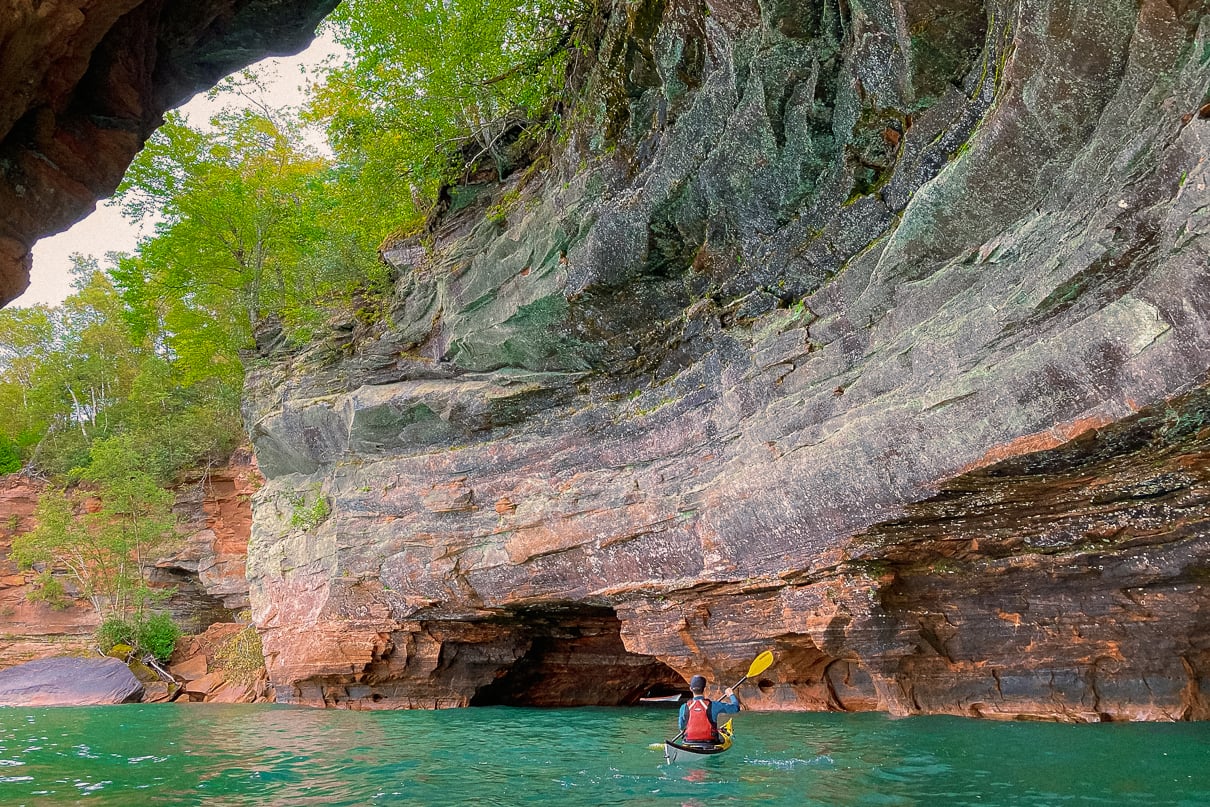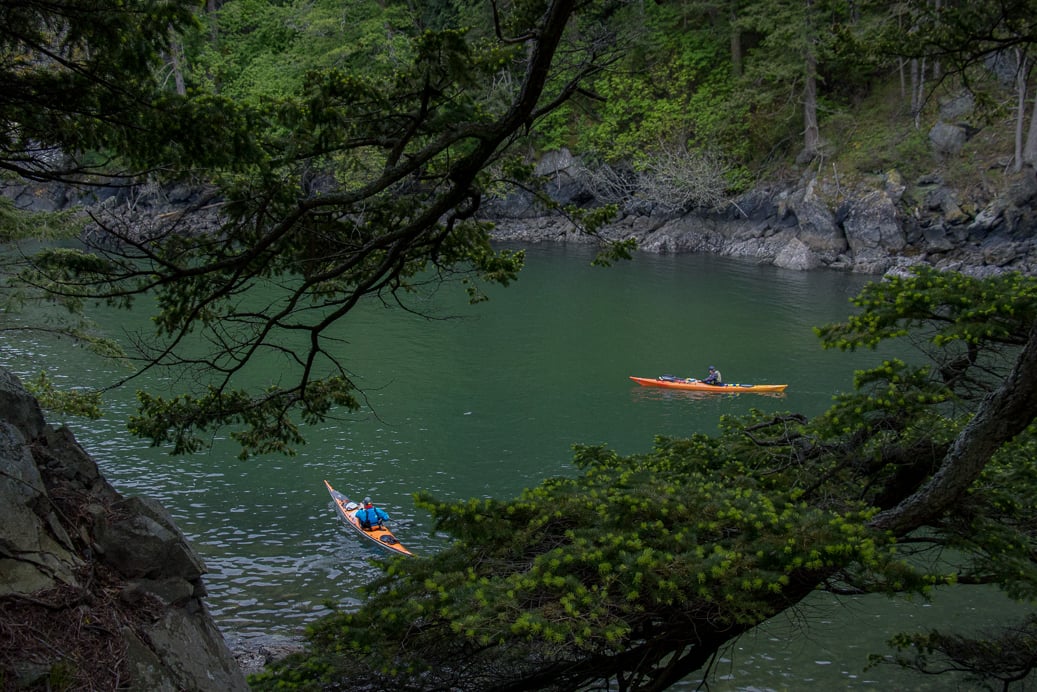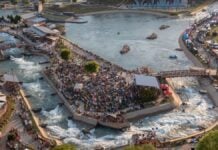At the northernmost point of Wisconsin lies the Apostle Islands—a chain of 21 federally-protected islands home to beachfront camping, crystal clear waters of Lake Superior, and unique sandstone sea caves. While gorgeous, the Apostle Islands National Lakeshore also poses a big risk for paddlers, with Lake Superior’s icy water capable of giving hypothermia year-round and sea states often closer to that of an ocean than a lake.
Within the Apostle Islands National Lakeshore the popular Meyers Beach acts as a gateway to the Meyers Beach sea caves— a popular “bucket-list” paddle for many, prone to large waves and conditions that can be difficult for the untrained eye to discern from the protected bay and the beach. There have been several fatal kayak incidents from this launch point, as well as a number of other fatal incidents throughout the park. The allure of red sandstone sea caves and clear green water can be hard for visitors to reckon with the risks.
Enter the seasonal ranger:
Visitors may be on their own this summer without guidance from National Park Rangers
At Meyers Beach, a friendly ranger waits with a pair of binoculars, a radio, the weather report and a smile to help prospective paddlers understand what they’re in for out on the lake. The rangers spot and talk with every paddler heading out on the lake to check for PFDs, sea kayaks with bulkheads, marine radios, spare paddles, and familiarity with the lake, and rescue knowledge. While the rangers don’t stop anyone from launching, they are there to educate and potentially redirect unprepared paddlers.

It’s hard to truly quantify the impact in lives saved and rescues prevented by the seasonal rangers in the Apostle Islands; statistics on things that could have happened are impossible to collect.
In the upcoming 2025 paddling season, visitors may be on their own.
Under U.S. President Trump’s push to cut federal spending, 3,400 recent hires of the U.S. Forest Service were laid off on February 14, with the National Park Service planning to terminate 1,000 workers. In addition, seasonal ranger’s jobs still hang in limbo with hiring offers for the 2025 summer season rescinded due to the federal hiring freeze.
Federal News Network reports that the National Park Service likely employs 7,000 to 8,000 seasonal employees. In the Apostle Islands there are about 38 full-time employees and two dozen seasonal staff according to Jeff Rennicke, Executive Director of Friends of the Apostle Islands.
“Seasonal workers in the Apostle Islands are the heart and soul, the boots on the ground, the paddles in the water of our national parks and lakeshores,” shared Rennicke.
Rennicke also shared that in the Apostle Islands National Lakeshore, seasonal workers roles also include skilled carpenters and electricians, people who help when paddlers get stuck in storms or lost, and search and rescue. Seasonal workers in the park pick up garbage, clear the trails, pump the outhouses, and warn you if there are bears in the area or other hazards.
“It’s the people who interpret the very values that the park was designated to protect in the first place,” said Rennicke. “The national parks are more than just scenery and the people who put the meaning behind that in large part is the seasonal workforce of the park service.”

In the Apostle Islands National Lakeshore and beyond cutting seasonal rangers could have deadly consequences
Notably in fall 2024, shortly after the rangers left for the season, the Coast Guard responded to an incident at the Meyers Beach caves involving capsized canoeists.
In August 2021, three National Park Rangers as well as Red Cliff Band of Lake Superior Chippewa Indians Warden responded to a harrowing incident along the Meyers Beach caves, when 5-8 ft waves left 11 kayakers stranded on a shallow rock shelf. Prior to both of these incidents, the Meyers Beach caves and greater Apostle Islands alike have seen a number of fatal kayak accidents, including an incident and recovery effort involving the death of a father and three children attempting to cross between islands in 2018 that made national news.
“At national parks and national park sites not everyone visiting necessarily has a lot of outdoor experience or does a lot of trip planning or reading about what they’re about to do,” shared Melanie, a former NPS seasonal ranger in the Apostle Islands National Lakeshore. “The big thing that the rangers do is they’re a source of information for what to expect while you’re in the park— what kind of weather conditions to expect, what kind of gear you need, what would be a good fit for your skill level.”
The National Parks are a massive attraction for visitors, with the National Park Service reporting 325.5 million recreation visits in 2023.
“These parks are such a huge draw for a lot of casual outdoor people, or people who just don’t have a lot of outdoor experience. If you take the rangers away you’re taking away that knowledge and that safety barrier,” explained Melanie.
When it comes to the impacts of the federal hiring freeze on National Parks, Rennicke warned it may already be too late to reverse some of the damage when it comes to trust between former park rangers and the federal government.
“The uncertainty level is extremely high, the morale is not real high and so I don’t think we can say ‘oh yeah they’re all going to jump back in and be there when we need it’,” said Rennicke. “Some of the damage in that regard is already done.”
National parks and how we treat them reflect on all of us
Beyond their value for recreation, National Parks also have dramatic economic importance for the communities around them. Great Smoky Mountains National Park saw 13 million visitors in 2023, making it the most visited park in that year, with an estimated cumulative benefit to the local economy of $3.4 billion. Meanwhile the Apostle Islands National Lakeshore saw 247,167 visitors in the same year, but even smaller park sites have a huge impact on local communities.
“The annual budget for Apostle Islands National Lakeshore is $3.5 million,” shared Rennicke. “The estimated economic benefit to local communities because of the park is $44.4 million. That means there’s a 1,305% return on investment from our park. That’s not inefficiency, that’s not government waste.”
Before his tenure as Executive Director at Friends of the Apostle Islands, Rennicke worked as a travel writer for National Geographic and travelled much of the world.
“The Apostle Islands National Lakeshore is truly and completely home to me. It’s a place that speaks not only in beauty but in history and adventure and stories,” explained Rennicke. “Our national parks are the envy of the world. When we hold up a national park we’re holding up what’s best about our landscapes, our history and ourselves and that reflects on all of us the way that we treat them.”
Rennicke went on to emphasize the importance of supporting National Parks partner organizations.
“I think it’s important that people recognize there are 450 support organizations, partner organizations that work with the National Park Service across the country,” shared Rennicke. “I direct people to the National Park Friends Alliance. We help people help the park, so it’s obviously a very important and direct way to go about things.”









The majority of American’s voted Trump into the President’s office, now we all get to experience (and most of us suffer) what he promised he would do.
The loss of federal jobs not only hurts outdoor enthusiasts. It hurts America. Many federal employees are veterans. Politicians utilize federal lands and the workforce that help preserve these areas as a bargaining chip. The slash of federal jobs is often done to not just balance the federal budget. It is a method to exercise power over the people. Under the guise of freedom the American people live. Ultimately both federal lands and those that work to protect these lands are just pawns. One might wonder is this ultimately a form of social control. Are we as Americans being ultimately told to be fearful and get in line? If our leadership will sacrifice the management of so many areas of the government which clearly as the article states creates a void ultimately leaving potential for dysfunction; there must be just cause. The only logical answer is that we are to know that “freedom” is not really the rite of being an American we all assumed was part of the package. We are being told that we will comply or lose. Now one would hope that this isn’t the case and our government desires to “just balance” the budget, cut spending, reduce taxes etc etc etc. These are all soundbites and bylines to keep the optimistic from raising too many questions. If the government plays to one’s ideals of prosperity they will comply with anything. Ahh so goes the road of imperialism. No empire survives forever. History repeats itself over and over. The same things always happen.